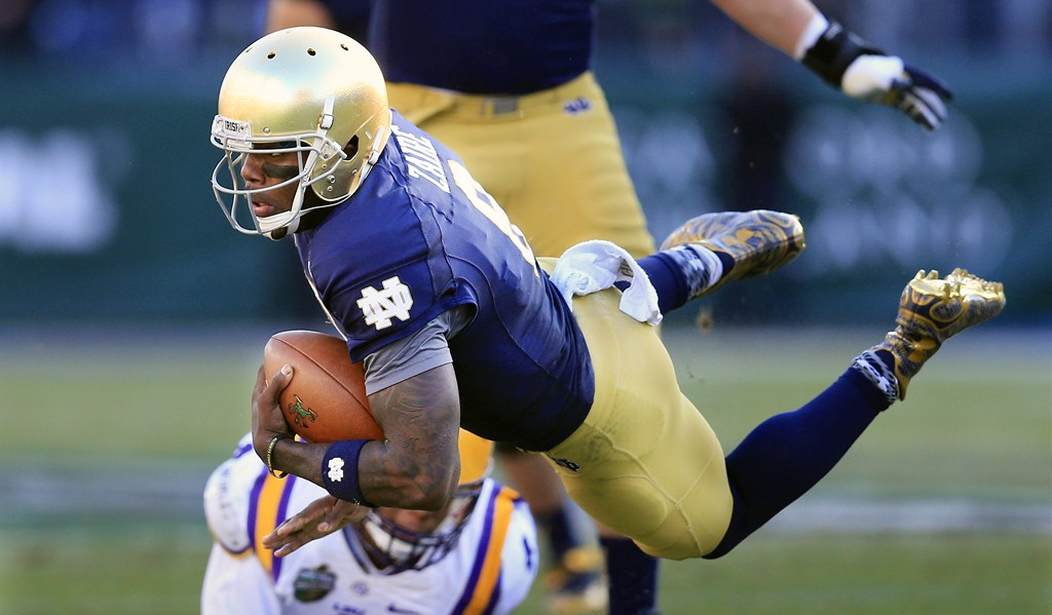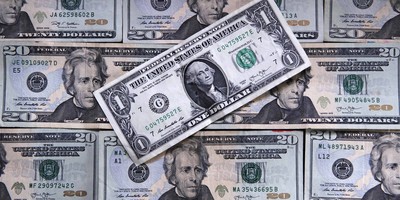The University of Notre Dame may have been one the biggest financial winners of the just-completed college football season, even though the private Catholic institution did not make the inaugural four-team playoff that featured big state universities.
If college football’s four playoff teams had been based on the valuation of their football programs, Notre Dame would have played No. 1 seeded Ohio State University, while the Buckeyes’ Big Ten rival the University of Michigan would held the second seed and squared off against the University of Texas. Those findings come from Ryan Brewer, an assistant professor of finance at the University of Indiana-Purdue, who values college football programs as if they could be sold on the open market.
At the end of the day, Notre Dame football is a financial “juggernaut,” Brewer said in a telephone interview.
The university’s athletic administrators “smartly reserve rights” that they expect will appreciate in value in the years ahead, Brewer said. Indeed, the value of the Notre Dame football program rose “significantly” during the past year, he added.
Despite Notre Dame suffering a late-season four-game losing streak after falling from the ranks of the unbeaten when a controversial call negated a potential game-winning touchdown against then-No. 1 Florida State University, the Fighting Irish is positioned “very well,” with a handful of other marque programs, Brewer said.
Brewer’s findings show that Ohio State University, which won the national title, ranked as the nation’s most valuable college football program, $1.13 billion, with revenue of $93.0 million. The University of Michigan finished second, with a value of $999.1 million, aided by revenue of $112.3 million, and the University of Texas, the previous year’s leader in valuation, fell to third, valued at $972.1 million, with revenue of $128.3 million.
Recommended
The University of Notre Dame’s valuation of $936.4 million ranked fourth, boosted by revenues of $102.5 million.
“Notre Dame isn’t the highest revenue-producing program but because of the mystique of the brand, it buoys the value,” Brewer explained.
Ohio State, Michigan and Texas all have football stadiums that seat more than 100,000 fans to keep their revenue base among the nation’s leaders. Notre Dame trails with a seating capacity of 80,795 at its storied stadium.
One reason why Notre Dame’s revenues fail to match up with some of the other major college football programs is due to the “smallish size” of its stadium, Brewer acknowledged.
But Notre Dame helped itself last year by scoring a new 10-year sponsorship deal with Under Armour (NYSE: UA). The Baltimore-based company will pay an estimated $90 million to design and supply the footwear, apparel and equipment for training and game-day uniforms for each of the university’s men’s and women’s varsity sports teams.
“This represents the largest financial commitment ever made by a brand to a university,” said Jack Swarbrick, Notre Dame’s athletic director, when the deal was announced during January 2014. “It will provide the critical resources we need to enable our student-athletes to compete at the highest levels.”
Notre Dame’s new affiliation with the Atlantic Coast Conference (ACC) also brought enthusiastic fans from visiting teams to the elite Catholic university during last fall’s football season. I participated in book signing events at the Hammes Notre Dame Bookstore on three different occasions during the fall as the author of a new inspirational book, “Holy Smokes! Golden Guidance from Notre Dame’s Championship Chaplain,” and I observed firsthand the buzz of fans from ACC universities.
The desirability of playing Notre Dame became clear when I talked to fans from the ACC’s University of North Carolina and Louisville University. However, supporters of the University of Michigan and some Notre Dame fans expressed disappointment that the Fighting Irish ended the traditional home-and-home series with last September’s game against the Wolverines.
Conference realignment not only caused Notre Dame to drop its annual clash with Michigan but also prevented the continuation of annual games with Purdue University and Michigan State University. What seemed clear from my conversations is that the fans of each university wanted Notre Dame on their team’s schedule and appreciated the chance to play school that Knute Rockne, George Gipp “the Gipper,” the “Four Horsemen” and scores of legendary players and coaches helped to make famous.
Sources of revenue are the same for most of the major football universities. But every major-conference school has its own “sweetheart deal” that includes TV rights, merchandise licensing deals and other cash-generating arrangements, Brewer said.
But only Notre Dame has a television contract for its home football games to be aired on a major network, NBC. That regular national exposure adds to the football program’s value and helps to allow Notre Dame to maintain its independence in football, despite agreeing to play five ACC games each fall and competing in the conference for all other sports.
“Part of what has helped its value is everything in equity markets and equities went up [last year], except for energy,” Brewer said. Both the Dow Jones Industrial Average and the S&P 500 hit new highs in recent months, he added.
Professional sports teams also demonstrated their value with lofty prices netted in the sale of two teams, Brewer said.
The NFL’s Buffalo Bills sold for $1.4 billion in cash during September 2014 and had a number of bidders. Former Microsoft [NYSE: MSFT] Chief Executive Officer Steve Ballmer bought the NBA’s Los Angeles Clippers for $2 billion in May 2014.
Brewer praised Notre Dame and Michigan for historically leading the way in generating cash flow from their football programs that they use to help their schools academically. He estimated each of those schools, which are the two winningest football programs in college football history, generated about $20 million that went back to the universities for other uses.
“Notre Dame is a trailblazer of doing the right thing,” Brewer said.
Paul Dykewicz is the editorial director of Eagle Financial Publications, editor of Eagle Daily Investor, a columnist for Townhall and Townhall Finance, and the author of a new inspirational book, “Holy Smokes! Golden Guidance from Notre Dame’s Championship Chaplain.” Follow Paul on Twitter @PaulDykewicz.

























Join the conversation as a VIP Member